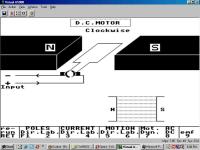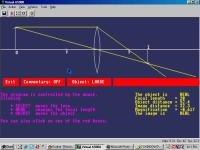



Real and Virtual Acorns in the Classroom
Andrew Harmsworth puts a copy of VirtualA5000 against a "real" RISC OS computer.
It is a sad fact that the number of Acorns in classrooms has declined rapidly over the past 3 years. The PC has become an expectation of parents, pupils, inspectors, LEA's and - in most cases - teachers. Where in all this is there any chance that the platform that once ruled the Education marketplace can get its foot back in the door to make a return? Some would say it's too late, the tide has turned, and no school that has gone down the PC route would consider purchasing new RISC OS hardware. However, there is a new player in town...
For a couple of years an Acorn emulator, Red Squirrel, for Windows PCs has been developed. However this had limited impact as it required users to get hold of ROM images of the RISC OS operating system, as well as an appropriate !Boot sequence, software etc, and for most this was too much effort to make the exercise worthwhile.
At the start of 2002, however, along comes Virtual Acorn - a company dedicated to selling a complete version of the Acorn emulator. This was advertised as not only having RISC OS 3.11 (by arrangement with Pace) but given the storage capacity of a CD, it was decided to ship it with a complete Hard Disc image, containing many freeware and shareware titles. Many of these were targetted at the Education market, and so it was that Virtual Acorn attended the BETT show at Olympia. Could there be a market for their first product - the Virtual A5000? Time would tell.
Into the Classroom!
The school in which I teach, like may others, has moved over to PCs, although in my department we still make use of Acorns (including one BBC!) for various purposes. Could VA5000 give us the opportunity of using RISC OS software more widely? I, and others, were dying to find out!
Putting in the VA5000 demo on the last RISC World CD I was disappointed to find out that I needed to upgrade Windows 98 to the latest version of DirectX. After a few little niggles, I was away. My PentiumII-333 was adequately able to boot, and I fired up Chris Johnson's invaluable GraphDraw to see what it could do.
GraphDraw runs superbly under VA5000! This was immediately excellent news for my lab, as students can now produce graphs quickly and easily on an A7000+ and my PC. Previously they've struggled to use MS Excel, and its output is not always helpful in a 'physics' sense. Several students, new to this country, let alone RISC OS, were immediately able to cope with using MENU on the mouse, and getting graphical output of their experiments in minutes.
VA5000 1 - Windows 0.
Make Haste Printing
Printing from VA5000 to a Windows printer is a little different to set up, as you might expect. A standard RISC OS printer driver is selected (to vaguely match the printer - e.g. I used an HP DeskJet 850C with a 930C printer) and the output routed via HostFS, the emulator's filing system. This then passes the output to the Windows printer driver, and off it goes! All in all, this appears to be almost as fast as printing using the standard RISC OS driver on a 'real' Acorn. Here are some benchmarks:
| Application | Printing Time: PC | Printing Time: VA5k |
|---|---|---|
| GraphDraw | 36s | 30s |
| Draw | 1 min 16s | 53s |
| Textease | 38s | 30s |
| Computers used in this test:
Acorn: 20MB A7000+ with !Printers 1.64 and DJ930Cv3 driver. PC: 64MB PII-333 with VA5000 1.10, !Printers 1.53 and DJ850C driver. | ||
So, whilst the well-specified A7000+ did better on average than VA5000, the difference is hardly apparent. In addition, a more up to date version of !Printers was used, together with the real 930C driver, on the Acorn.
Back to BASIC
What about more substantial programs? One of my colleagues has a vast number of BBC BASIC programs he wrote back in the early eighties. How would VA5000 cope with running these? On my PII, they were all fine. No doubt these programs should be made available for all. On his own laboratory PC, however, the demo of VA5000 was unable to cope. The Citrix processor was simply not up to the task. Nor was his office AMD machine much use. On both machines the boot time was several minutes.
By this time, version 1.10 of VA5000 was available, and I was lucky enough to be able to test it. Incredibly the speed-ups of code were enough to allow the AMD to fire up RISC OS in a sensible time. More importantly, running the BASIC programs was as good as running them on original hardware. The lab Citrix machine, however was still not up to it, perhaps the result of its graphics card being a little incapable by current standards. Shown below are two screenshots of teaching software running on VA5000:

Fig. 1: "DC Motor" teaching software
Some of the programs we have cannot be run on my A7000+ due to the screen modes used. VA5000, however, is able to cope with all of them. Having the ability to run this at all - even if through a PC - is an absolute winner. Another Brownie point for VA5000.
Excelling Itself
Another colleague had recently had a year 9 class investigate the varying strengths of electromagnets. He had collated all their data into an Excel spreadsheet, the idea being to produce 10 sets of graphs on the same set of axes. This it could do, but it cannot sensibly add bestfit lines to each data set, as the ranges were incompatible. I found him adding hand-drawn curves and lines to each set of results.
Commenting that this might be handled by GraphDraw and its sister application, Multiplot, I had him email me the results. Saving out CSV files from Excel, I was quickly able to produce a set of graphs to load into Multiplot. Problem: as standard it could not handle all the graphs at once! After a single email to Chris, he was quickly able to tell me how to read the manual, and Multiplot had given us the over-layed graphs we wanted!
VA5000: 2 Windows: 0.
Early Conclusions
There is never a good time to try out new things in a school environment. There are always other priorities. However, it seems to me that the Virtual Acorn emulator is a fine product that has more of a place in schools than I originally believed. Not only will it allow reluctant PC converts to go back to using Acorn software, but it also allows old Acorn software to be run where modern Acorn machines fail.
In my classroom, its introduction has already greatly enhanced my students' ability to analyse experimental results with GraphDraw, as an alternative to the chunky Excel. No doubt over the coming term I will find many more uses for it. The very existence of VA5000 broadens the choice of software one has available, and so the most appropriate tool once again is available to all.
I leave it to others to speculate as to whether or not Virtual Acorn will bring new users to this platform, or encourage the sale of "real" RISC OS hardware. Let us hope so!
Andrew Harmsworth
